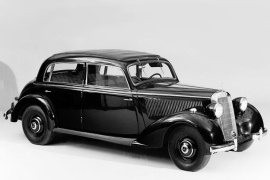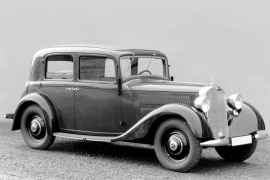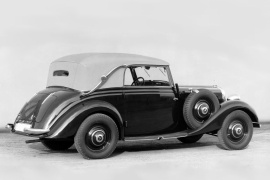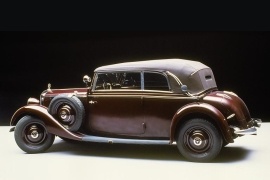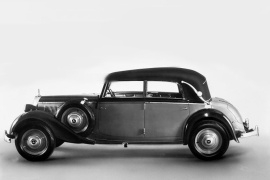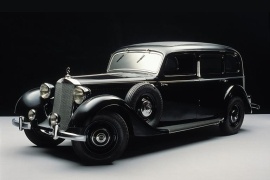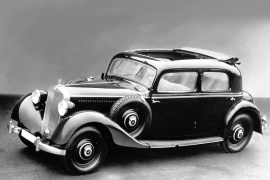MERCEDES BENZ Typ 230, 260 D Models/Series Timeline, Specifications & Photos
First production year: 1936
Engines: Gasoline, Diesel
When Mercedes-Benz introduced the Typ 230 N in 1937, it understood that it had made a terrible mistake by launching a long car based on a too short wheelbase vehicle, which led to a long rear overhang. The carmaker fixed that mistake in 1938 when it brought the Typ 230.
Mercedes-Benz didn't want to make any compromise and thought that the N-version could work well. But, unfortunately, that was not true, and soon the customers started to complain. Moreover, the normal (short) wheelbase version created an uncomfortable sensation for the rear seat occupants.
Thus, the result came in the shape of another vehicle, dubbed Typ 230, without any letter attached at the end. But the vehicle's styling remained the same. At the front, the Mercedes-Benz specific grille with a slightly raked, pinned-out radiator led the impression of a sporty vehicle. The arched wheel fenders at the front flanked the tall and narrow engine compartment and were followed by the side steps needed to help occupants get in and out of the cabin. Moreover, both doors were hinged onto the B-pillar. Thus, the front passenger could get out and quickly open the rear door.
Inside, there was plenty of legroom thanks to the 3-meter (9.8 ft.) wheelbase, which was just 30 cm (one foot) longer than the one offered for the N21. At the front, depending on the option, the carmaker installed either a pair of seats or a bench wide enough to accommodate three persons. This 1938 Typ 230 featured a luxurious interior like most other Mercedes-Benz vehicles.
Under the hood, the carmaker placed the same 2.3-liter powerplant, hence the 230 name, paired with a four-speed manual transmission.
Mercedes-Benz replaced the N21 model in 1937 with the Typ 230 N, W143 model to make the car attractive for more people, but it was hardly a successful vehicle.
Mercedes-Benz introduced the Typ 230 N on the same chassis as its predecessor and with the same wheelbase, but the bodywork was longer. That led to a somehow disproportionate design with a very long rear overhang. The German carmaker realized that and introduced, as an option, a long-wheelbase version which proved to be more successful on the market. From 1938, Mercedes-Benz dropped the N (short-wheelbase) version.
The bodywork was sleeker than on the N21 model, with a slightly raked, pined-out radiator. Unlike more expensive Mercedes-Benz models, the Typ 230 N featured wheel-arches mounted headlights. At the bottom, its chromed and profiled metallic bumper was completely different than on its predecessor. In the back, the slightly racked-forward rear end made room for a luggage compartment, which was accessible from the outside.
Inside, the car was quite roomy for four adults. Its front, rear-hinged doors helped its occupants get out easier than most of the other four-doors sedans on the market. That was one of the reasons why the special Nazi forces used the Typ 230 N.
Under the hood, the German carmaker installed an inline-six engine with a 2.3-liter displacement, hence the car's name, that provided 55 hp. It was paired to a four-speed manual gearbox. Mercedes-Benz installed an independent suspension with leaf-springs in all corners to provide more comfort and a better cornering speed.
Mercedes-Benz introduced a facelift for the Typ 230 at the International Motor and Motorcycle Show in Berlin and built the car in two wheelbase options: N and L.
While the N stood for Normal wheelbase, the L stood for the long-wheelbase version. Although those times, official records didn't refer to them as N or L. That differentiation came later. While the more extended version enjoyed a successful presence on the market, the N was barely sold in 1000 units and forced the carmaker to withdraw it from the price lists silently. Yet, the Cabriolet C was a good offer for those times since it was an open-top premium vehicle with four seats inside.
Along with the facelifted version, the 230 N Cabriolet C received a tilted radiator grille at the front and new headlamps enclosed inside more spherical housings, directly attached to the front fenders on cast legs. The carmaker installed the spare wheels on both sides of the engine compartment, leaving the car's back only for the trunk. On the sides, the rear-hinged doors eased the ingress and egress, especially for the rear-seat passengers. The removable rag-top stood behind the rear bench when folded.
The cabin was fit for four adults, although it offered limited legroom for the rear ones. Still, it was adequate for short, urban trips or longer journeys with children in the back.
Under the hood, the German carmaker installed an inline-six engine with a 2.3-liter displacement, hence the car's name, that provided 55 hp. Mercedes paired it to a four-speed manual gearbox. Mercedes-Benz installed an independent suspension with leaf springs in all corners.
After successfully introducing the new Typ 230 based on the W143 platform in 1936, Mercedes-Benz made another step in 1937 and unveiled the Cabriolet B version.
Since both cars were based on the same platform, it was natural that they shared some major components. Thus, besides the powertrain, the carmaker carried over bodywork and interior parts from the main sedan version. But there were also some significant differences between them. First and foremost, the Cabriolet B was, obviously, a rag-top.
With its slightly tilted backward chromed radiator, the Typ 230 showed some interest from the carmaker in building its cars more aerodynamic. It wasn't too far from the main design language of the carmaker, but it was a beginning. Also, the arched, long front fenders supported a cross-bar between them for the headlights. A third light was placed in the middle either as a reserve or as an additional lighting power for pitch-black nights. The chromed bumper at the front was optional and mounted directly on the chassis's ends.
Unlike the Cabriolet A, which offered three seats, the Cabriolet B was based on a longer wheelbase and thus, the carmaker was able to install a regular bench in the back suitable for two adults. In addition, the front bucket seats were wide enough for those times' standards.
Under the hood, the carmaker offered the Cabriolet B with the same gasoline-powered inline-four engine that put the sedan version in motion, namely the 2.3-liter powerplant. It was paired to a three-speed manual gearbox.
Mercedes-Benz introduced the Type 230 as a long-wheelbase Type 200 and evolved into one of the most successful ranges before WWII, and the Cabriolet D had unique merit for that.
Just a year after the W143 Series was introduced, Daimler-Benz came with a facelifted version for the entire lineup. That brought a slightly modified pinned-out radiator, and new headlights mounted directly on the front fenders. Along with that, it introduced a four-door, long-wheelbase version of the open-top Type 230, which allowed a comfortable ingress and egress from the vehicle, especially with the top down, for all passengers.
The German carmaker was not at its first four-door open-top vehicle, and its customers awaited that version. While most of the convertibles built by Mercedes-Benz featured two doors and four or five seats, the D-version was offered with four doors. The front-ones were rear-hinged while the rear ones were hinged-forward. Thus, the front occupants had an easier way to step out of the car. Also, that system allowed the driver to quickly step down and open the door for the rear occupants.
Inside, the 230 Cabriolet D was very spacious due to its long wheelbase. The carmaker made a quick-release system for the B-pillar, thus allowing the users to have a completely open area after the windshield.
Under the hood, the German carmaker installed an inline-six engine with a 2.3-liter displacement, hence the car's name, that provided 55 hp. It was paired to a synchromesh four-speed manual gearbox with direct-drive for the fourth gear. Mercedes-Benz installed a wider track both front and rear and an independent suspension with leaf-springs in all corners to provide more comfort and a better cornering speed.
In February 1936 at the Berlin Motor Show, Daimler-Benz presented the 260 D in the form of a six-seater Pullman landaulet, 13 units of which had been built since July 1935.
At the same show, there was the Hanomag Rekord, another diesel-engined passenger car, although this did not go into series production until 1938. Consequently, the 260 D was the world's first series-produced diesel-engined passenger car. From September 1936, the 260 D was available in more body variants. Apart from the Pullman Landaulet, there were three other versions: a closed Pullman sedan, a four-seater, and a four/five-seater convertible.
In 1937, a facelifted variant was launched with some modifications to the radiator. The headlights were smaller and enclosed in spherical housings, directly attached to the front fenders. That solution led to the dispense of the chrome-plated transverse rod in front of the radiator.
Inside, the 260 D was very spacious due to its long wheelbase. It was offered in various versions, with seating for up to seven passengers. It was mostly used by the cab-companies, proving the fuel-efficiency of the diesel engine.
It featured a 2.6-liter four-cylinder engine that offered 45 hp mated to a four-speed manual transmission with direct-drive fourth gear. By December 1940, 1.967 units of the 260 D, known within the company as the W 138, had been built.
Mercedes-Benz introduced the Type 230 as a long-wheelbase version for the Type 200 in 1936 as a four-door sedan or top-cabriolet.
While the Hindenburg airship took its maiden flight in March 1936, creating a direct flight connection between Germany and the U.S., on the ground, Mercedes-Benz was stronger than ever. It introduced the W143 model in May. Despite the economic depression, the carmaker continued improving its products and developing new models to get more customers.
The carmaker built the W143 with a similar look as the 200. Its tilted radiator was already an established brand image together with the headlights connected via a chromed bar between them. Its designers extended the curved front fenders towards the back of the car, forming two side steps to ease the ingress and egress from the vehicle. Mercedes installed the door-hinges only on the B-pillars. At the back, the trunk included a spare wheel.
Inside, the carmaker installed two individual seats at the front and a bench in the back. Its flat dash panel included the dials in the middle. It was a comfortable, roomy vehicle for five adults. Its four cranked windows allowed the passengers to get more fresh air. A top-cabriolet version was also available.
Under the hood, the German carmaker installed an inline-six engine with a 2.3-liter displacement, hence the car's name, that provided 55 hp. It was paired to a synchromesh four-speed manual gearbox with direct-drive for the fourth gear. Mercedes-Benz installed a wider track both front and rear and an independent suspension with leaf springs in all corners to provide more comfort and a better cornering speed.
